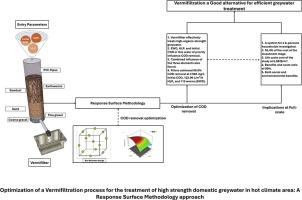当前位置:
X-MOL 学术
›
Water Res.
›
论文详情
Our official English website, www.x-mol.net, welcomes your
feedback! (Note: you will need to create a separate account there.)
Optimization of a vermifiltration process for the treatment of high strength domestic greywater in hot climate area: A Response Surface Methodology approach
Water Research ( IF 11.4 ) Pub Date : 2024-11-19 , DOI: 10.1016/j.watres.2024.122803 Sidesse S.Y. Saapi, Harinaivo A. Andrianisa, Malicki Zorom, Lawani A. Mounirou, Swaib Semiyaga, Noel Tindouré
Water Research ( IF 11.4 ) Pub Date : 2024-11-19 , DOI: 10.1016/j.watres.2024.122803 Sidesse S.Y. Saapi, Harinaivo A. Andrianisa, Malicki Zorom, Lawani A. Mounirou, Swaib Semiyaga, Noel Tindouré

|
Discharging untreated or partially treated greywater spreads diseases to humans and depletes dissolved oxygen in water, endangering aquatic life. Current greywater treatment methods often require high capital investment, large floor space, and significant energy, whereas vermifiltration is an ecologically safe, cost-effective technology that efficiently reduces high levels of organic matter in wastewater. The present study focuses on the modeling and optimization of COD removal of a vermifiltration system, using Response Surface Methodology. The vermifilter consists of sawdust, sand, and gravel as filter media, and Eudrilus Eugenia as worm species. Experiences were conducted at room temperatures (26 - 31 °C). Key factors considered as influencing COD removal were hydraulic loading rate (HLR), initial COD, and earthworm density (EWD). All three factors significantly impacted COD removal, with notable cross effects. The model predicted a maximum COD removal of 91.51 % for influent with 1087 mg/L COD, 178 earthworms, and 133 L/m²/day HLR, achieving a residual COD value of 92.29 mg/L, that meet the requirements for the WHO discharge guidelines. However, due to high variability of household greywater quality in the area, the system has been full-scale designed for the value of 2500 mg/L which corresponds according to the model, to 123L/m²/day HLR. The life cycle cost (LCC) of the treated water is therefore 0.083USdollars /m3 . Earthworm's growth was satisfactory (17 - 52.5 %) in most filters. Finally, results suggest that the model can be used to design field-scale vermifiltration systems with minimal variation.
中文翻译:

炎热气候地区处理高强度生活灰水的蠕虫过滤工艺优化:响应面方法方法
排放未经处理或部分处理的灰水会将疾病传播给人类,并耗尽水中的溶解氧,危及水生生物。目前的灰水处理方法通常需要高资本投资、大占地面积和大量能源,而蠕虫过滤是一种生态安全、经济高效的技术,可有效减少废水中的高水平有机物。本研究的重点是使用响应面方法对蠕虫过滤系统的 COD 去除进行建模和优化。蚯蚓过滤器由锯末、沙子和砾石作为过滤介质,Eudrilus Eugenia 作为蠕虫种类组成。在室温 (26 - 31 °C) 下进行体验。影响 COD 去除的关键因素是水力负荷率 (HLR) 、初始 COD 和蚯蚓密度 (EWD)。这三个因素都显著影响了 COD 的去除,并产生了显著的交叉效应。该模型预测,对于 1087 mg/L COD、178 条蚯蚓和 133 L/m²/天 HLR,进水的最大 COD 去除率为 91.51%,残余 COD 值为 92.29 mg/L,符合 WHO 排放指南的要求。然而,由于该地区家庭灰水水质的高度可变性,该系统已全面设计为 2500 mg/L,根据模型,HLR 为 123L/m²/天。因此,处理水的生命周期成本 (LCC) 为 0.083 美元/m3。在大多数过滤器中,蚯蚓的生长令人满意 (17 - 52.5 %)。最后,结果表明该模型可用于设计变化最小的田间规模的蚯蚓过滤系统。
更新日期:2024-11-19
中文翻译:

炎热气候地区处理高强度生活灰水的蠕虫过滤工艺优化:响应面方法方法
排放未经处理或部分处理的灰水会将疾病传播给人类,并耗尽水中的溶解氧,危及水生生物。目前的灰水处理方法通常需要高资本投资、大占地面积和大量能源,而蠕虫过滤是一种生态安全、经济高效的技术,可有效减少废水中的高水平有机物。本研究的重点是使用响应面方法对蠕虫过滤系统的 COD 去除进行建模和优化。蚯蚓过滤器由锯末、沙子和砾石作为过滤介质,Eudrilus Eugenia 作为蠕虫种类组成。在室温 (26 - 31 °C) 下进行体验。影响 COD 去除的关键因素是水力负荷率 (HLR) 、初始 COD 和蚯蚓密度 (EWD)。这三个因素都显著影响了 COD 的去除,并产生了显著的交叉效应。该模型预测,对于 1087 mg/L COD、178 条蚯蚓和 133 L/m²/天 HLR,进水的最大 COD 去除率为 91.51%,残余 COD 值为 92.29 mg/L,符合 WHO 排放指南的要求。然而,由于该地区家庭灰水水质的高度可变性,该系统已全面设计为 2500 mg/L,根据模型,HLR 为 123L/m²/天。因此,处理水的生命周期成本 (LCC) 为 0.083 美元/m3。在大多数过滤器中,蚯蚓的生长令人满意 (17 - 52.5 %)。最后,结果表明该模型可用于设计变化最小的田间规模的蚯蚓过滤系统。

































 京公网安备 11010802027423号
京公网安备 11010802027423号